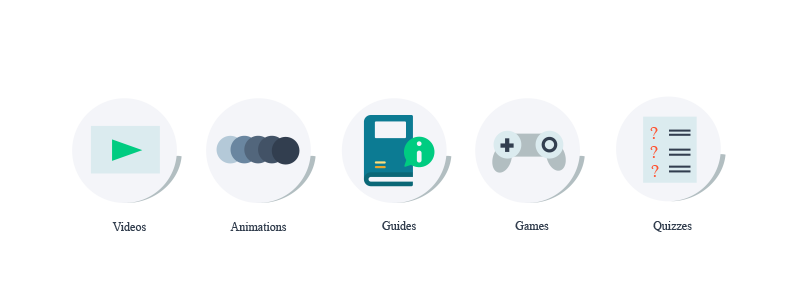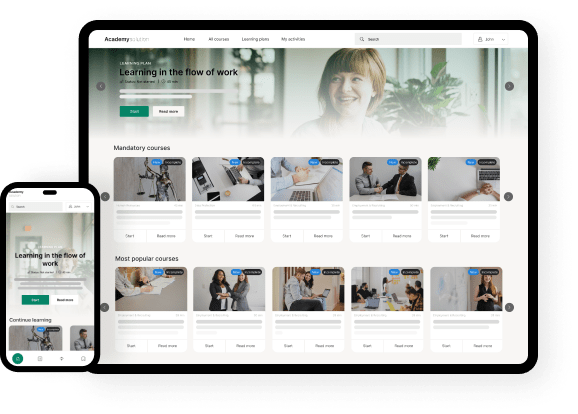Corporate learning has come a long way. Companies have become witnesses to its swift evolution. As far as the history of formal corporate training is concerned, it dates back to the early 1900s. It started when printing press manufacturer Hoe and Company came up with the first documented factory school that trained machinists. After a century, the internet revolution paved the way to E-learning. It then shaped the entire corporate learning landscape. That’s why some consider e-learning as the future of corporate learning. But what exactly is e-learning?
What is e-learning?
E-learning, or electronic learning, is the delivery of learning content through digital resources. Digital resources are electronic devices such as laptops, tablets, or smartphones.
Take note that the concept of e-learning is not just about the use of these electronic devices. It also pertains to adapting to different learning needs and styles through digitalization.
It may be hackneyed but as e-learning starts to become more ubiquitous and in demand, businesses started to adapt and find ways to stand out.
This call is not just a teeny buzz in the global market. As a matter of fact, statistics show how the e-learning industry continues to expand and create resonance among corporate communities.
Ten Notable Statistics About E-learning
The coronavirus pushed nations’ economies on the brink of collapse which marked 2021 a year to look forward to. Aside from the enthusiasm and optimism, companies wanted to shift gears and explore different options to bounce back.
During the pandemic, different organizations saw the rise of e-learning as a backup for corporate learning academies. But even before Covid-19 entered the scene, E-learning has been taking the global market by storm. Along with this rapid expansion and development is the continuous digital transformation inside workplaces.
As an evidence to this salient progress, here are ten notable facts about the e-learning industry:
- The global e-learning market is expected to reach $275.10 billion by 2022 according to Zion Market Research statistics where the demand projections for digital transformation products are $431.71 billion by 2021 and for the global e-learning market, $331 billion by 2025, according to Accuray Research LLP.
- E-learning has prompted an increase in income for 42% of organizations.
- 72% of organizations believe that e-learning gives them a competitive advantage.
- According to eLearning Industry, the total spending by the US government for self-paced learning will fall to $2.035 billion by 2021.
- 67% of organizations offer mobile learning.
- 99% of mobile users believe that mobile learning enhances their experience, says eLearning Industry.
- IBM saved approximately $200 million after switching to e-learning.
- According to Global News Wire, mobile learning could grow to reach $78.5 billion worldwide by 2025.
- Sources say, that IBM by implementing an e-learning program found that participants learned nearly five times more material without increasing time spent in training.
- Molly Fletcher Company states that organizations can achieve an 18 % boost in employee engagement by using e-learning technology.
Shaping Corporate Learning Academies Through E-learning
With the aforementioned facts, it shows that companies have shown eagerness to keep up with the changing needs in the corporate setting. While the term “learning academy” appears relatively unheard-of, it simply means a central educational hub for organizations. Its primary purpose is to translate relevant corporate information to training initiatives. Corporate learning programs accompany learning instruments designed to train or impart information to employees.
A learning academy is instrumental to amplifying concrete business goals. These goals are then strategically echoed to employees to educate them about their role and responsibilities as “stakeholders” or “partners.”
E-learning has been transforming corporate learning academies and has improved both user and administrative experience. A concrete indication would be the continuous enhancement on reporting capabilities and a strong emphasis on mobile compatibility.
Since the whole point of corporate training is to support learners in all instances where learning is required, administrators need more than what’s mentioned above.
E-learning and the Social Learning Phenomenon
The concept social interaction has always been the cornerstone of every corporate training. Since it is intrinsic to learners to exercise collaboration, the influx of social media sites (e.g., Facebook, Twitter, and LinkedIn) has become a testament to the increasing popularity of social learning.
Learning “with and from” others has now become the ethos of every learning academy. For instance, according to Harvard Business Review, employees now spend about 50% more time engaged in collaborative work. On the other hand, a survey made by Queens University of Charlotte suggests that 75% of employees regard collaboration and teamwork as important.
The use of a Learning Management System or LMS in E-Learning can be an effective tool to maximize social learning. With built-in social media functionalities, companies can optimize the quality of corporate learning. An example would be enabling learners to create rooms for forums that help facilitate sharing of learning experiences.
Learning Through Mobile Experience
There is a rapid growth in mobile device usage across organizations. In fact, it is said that 47 % of institutions use mobile devices in their training programs. With 30 % of the workforce being millennials, the use of mobile phones has shown a major impact on corporate training efforts. For example, an LMS is now designed based on a “mobile-first” approach. What does it mean?
A mobile-first approach is a process that involves designing a responsive product or software with your mobile users in mind. This includes software development. Such development involves creating designs that contribute to a mobile-friendly experience. An effort like this gave birth to what many call now as “mobile learning.”
Mobile learning or M-learning is a way of accessing learning content through mobile devices whenever and wherever learners want to. The basics of mobile learning include delivery of microlearning content (e.g., videos, animations, guides, games, and quizzes.) It may also comprise the elements of social learning.

While mobile devices were used from a basic to a limited extent, there’s no arguing that mobile learning has its biggest upside.

Promotes flexible learning
Mobile learning eliminates the need for face-to-face learning, thus allowing flexibility. With the use of instructional contents like videos, podcasts, and other multi-media formats, you can now integrate learning with students’ daily routine.
Provides bite-sized learning content
The birth of microlearning created bite-sized learning content that can be readily accessible when needed. Since learning nuggets can be digested easily, information is most likely processed meaningfully.
Improves knowledge retention
Learners are more likely to remember crisp and concise data. Mobile learning improves knowledge retention and information recall. This is because digestion of bite-sized data is healthier to the brain’s information-processing system.
Ensures quick availability of learning content
Whenever a learner or employee has a task to perform, there’s a unique advantage that mobile learning provides. That’s availability. Learners have the ability to log into learning sessions at their convenience since training is not confined to any physical location or specific time.
Easily accommodates the millennial workforce
As mentioned earlier, 30 % of the workforce comprises millennials. These people have grown around using mobile devices to run through their daily tasks. From sending or reading emails and reviewing notes, they are functioning based on a digital-first mindset. With mobile learning, training content is seamlessly designed according to how millennials think and work.
You learned that innovation isn’t just an inherent quality, but rather something that is cultivated within a company through a collected effort. Keeping up with the changing needs in corporate learning requires embracing innovation and encouraging innovative ideas.
To begin with this work, it is important for organizations to continually build on established training approaches and repurpose those with little impact. If you would recall, e-learning gives you the best of both worlds. You can both bank on your existing training strategies while leveraging new technology during the process.
In an article published in Training Magazine, it says, “As more and more Training departments continue to do more with less, and new generations of workers clamor for just-in-time training on their devices, companies increasingly are converting classroom courses to e-learning—or least implementing a blended approach.”
Without a doubt, e-learning is here to stay and will continue to make significant progress.
Start Your E-learning Campaign Now with Cursum
For a business or organization that is looking for a significant boost in corporate learning and development, consider e-learning. But of course, with the number of options and solution providers out there, selecting one will be a crucial decision. Find someone who’s doesn’t only have the expertise and years of experience, also consider a provider who possesses a “business-first” mindset.
At Cursum, we help companies reach business milestones by providing them top-notch solutions designed to respond to their specific needs. Whether it be designing an LMS for onboarding, compliance training, or employee development, we make sure that we keep our customers at the core of the process. We have our partners’ success stories to serve as a testament to our undying dedication to providing only powerful and reliable SaaS solutions.
With learning academies being the face of today’s corporate learning, today is the perfect time to consider modernizing your approach and get that ball rolling.


